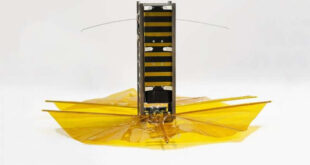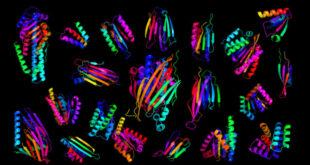Adult cardiac stem cells don’t exist, according to a new study in mice by researchers from the Hubrecht Institute, the Amsterdam University Medical Center, the École Normale Supérieure de Lyon and the Francis Crick Institute London.
Part of the heart wall of the murine heart after myocardial infarction; visible are the scar tissue (red) and dead heart muscle cells (pale green). Image credit: Hubrecht Institute.
For two decades researchers have searched for cardiac stem cells — stem cells that should reside in the heart muscle and could repair it after a myocardial infarction.
Multiple research groups have claimed the definitive identification of cardiac stem cells, yet none of these claims have held up.
The existence of these cells and their significance for adult hearts remains therefore heavily debated.
To solve this debate, Professor Hans Clevers of the Hubrecht Institute, the University Medical Center Utrecht and Utrecht University and co-authors focused on the broadest and most direct definition of stem cell function in the mouse heart: the ability of a cell to replace lost tissue by cell division.
In the heart, this means that any cell that can produce new heart muscle cells after a heart attack would be termed a cardiac stem cell.
The researchers generated a ‘cell-by-cell’ map of all dividing cardiac cells before and after a myocardial infarction using advanced molecular and genetic technologies.
They found that many types of cells divide upon damage of the heart, but that none of these are capable of generating new heart muscle.
“In fact, many of the ‘false leads’ of past studies can now be explained: cells that were previously named cardiac stem cells now turn out to produce blood vessels or immune cells, but never heart muscle,” they said.
“Thus, the sobering conclusion is drawn that heart stem cells do not exist.”
“In other words, heart muscle that is lost due to a heart attack cannot be replaced. This finding settles a long-standing controversy.”
The scar in the murine heart after myocardial infarction; scar tissue is shown in red; heart muscle cells are shown in green. Image credit: Hubrecht Institute.
Professor Clevers and colleagues made a second important observation.
“Connective tissue cells — also known as fibroblasts — that are intermingled with heart muscle cells respond vigorously to a myocardial infarction by undergoing multiple cell divisions,” they explained.
“In doing so, they produce scar tissue that replaces the lost cardiac muscle.”
“While this scar tissue contains no muscle and thus does not contribute to the pump function of the heart, the fibrotic scar ‘holds together’ the infarcted area.”
“Indeed, when the formation of the scar tissue is blocked, the mice succumb to acute cardiac rupture.”
“Thus, while scar formation is generally seen as a negative outcome of myocardial infarction, it’s important for maintaining the integrity of the heart.”
The study will be published in the Proceedings of the National Academy of Sciences.
_____
Kai Kretzschmar et al. 2018. Profiling proliferative cells and their progeny in damaged murine hearts. PNAS, in press; doi: 10.1073/pnas.1805829115
 #Bizwhiznetwork.com Innovation ΛI |Technology News
#Bizwhiznetwork.com Innovation ΛI |Technology News





